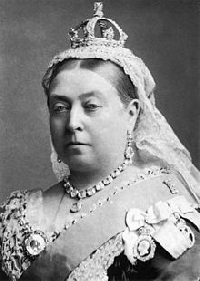
Victorian design style is always popular in decorative arts and architecture
The Victorian Age was named after Queen Victoria, who reigned over England from 1837-1901. She was, conceivably, the first world-wide super-star. What the Queen did, said, her attitudes and beliefs had a huge influence on the rest of the world.
An era of prosperity, peace and cultivated sensibilities and one of idealization and spirituality in regard to social values, the arts and religion, people continue to love Victorian design style and time period. Perhaps because it evokes a sense of romanticism. People are drawn to the architecture, decorative arts, fashion, period home furnishings and literature.
Home Interior
The colors used inside the homes for the trademark romantic furnishings and textiles were tertiary hues, or those made by combining equal amounts of primary and secondary colors.
Dining room and libraries in this era displayed rich hues including dark green and gray-blue, prevalent choices because the dark colors concealed stains from oil and gas lamps and soot and grime from coal dust.
The desired color palette: Restrained and warm, favoring teals, mustardy golds and yellow, plum, rust, burgundy, blue and sage and olive green. Many ladies’ bedrooms boasted dusty rose of lavender paint. This is a very romantic look, to this day.
~
Furniture
Furniture was sumptuously upholstered and layered window treatments were in vogue. Furniture was considerable in size. This was not a time for restraint or minimalism but rather of opulence. More was more. Excess was in, not moderation.
Lampshades were embellished with fringe and sparkling baubles and framed paintings and photographs hung from the walls. Photography was new. The Queen was the first monarch photographed. If the Queen did it, everyone else wanted to do likewise.
During this time in history, nothing was plain or simple. This group loved knick-knacks and was not shy about putting them on display in their homes. Those with money liked to show off their wealth. It was an era of conspicuous consumption
Among other characteristics emblematic of this era was the importance of etiquette, manners and proper behavior. Men were gentlemen and women, ladies.
Flowers and their meanings, which is the art of floriography, was created. One could send cryptic or coded messages such as “I love you” or “You are doomed” based on the flowers the person chose to send or the manner in which the flowers were arranged. If you received an upside down bouquet, uh oh! Watch your back!
Architecture
Victorian architecture has survived around the world. People continue constructing homes in this style, a hybrid of historical architectural patterns as well as inclusion of Asian and Middle East influences, because of its inherent appeal.
These structures are sometime referred to as ‘gingerbread’ or ‘painted ladies.’ Painted ladies denote Victorian and Edwardian buildings painted in three or more colors. Using multiple hues augments the architectural details of a building. There are cities that have entire neighborhoods filled with whimsical and vibrantly painted structures.
Fabrics
Damask, floral chintz and velvet materials featuring stripes, geometric designs and floral prints are typical of this time. Patterns were featured on walls, in the curtains and on the carpets. Many homes featured Oriental rugs.
If you are a devotee of Victoriana and want to create the same look in your home be careful it does not end up looking jumbled and muddled rather than sophisticated and romantic. It takes skill incorporating all the frou-frou so loved and desired in this era.
